Why Emergency Evacuation Planning Requires Proper Equipment
Evac chairs are specialized mobility devices designed to safely transport people with limited mobility down stairs during emergencies when elevators cannot be used. These life-saving devices use track systems or wheels with braking mechanisms to provide controlled descent, typically operated by one or two trained assistants.
Quick Facts About Evac Chairs:
- Weight capacity: Most models support 350-500 lbs
- Operation: Single-person or dual-operator designs available
- Power options: Manual track systems or battery-powered models
- Cost range: $130-$3,800 depending on features
- Legal requirement: Required in many multi-story buildings under fire codes and ADA compliance
When David Egen carried his mobility-impaired wife down 38 flights of stairs during an emergency in the early 1980s, he realized there had to be a better way. His experience led to the invention of the modern evacuation chair - a device that has since saved countless lives, including during the World Trade Center evacuation on September 11, 2001.
The statistics are sobering: by 2056, seniors will make up 28% of Canada's population, with 33% of those over 65 experiencing mobility-related disabilities. In the US, 40% of people over 65 have some form of disability, with 26% facing mobility challenges.
The reality is stark: during emergencies like fires, earthquakes, or power outages, elevators become death traps. Building codes prohibit their use, leaving stairs as the only escape route. For someone in a wheelchair or with limited mobility, those stairs can become an impossible barrier without the right equipment.
As specialists at American Mortuary Coolers, we've worked extensively with facilities requiring specialized safety equipment, including evac chairs for multi-level buildings. Our experience with custom equipment solutions has shown us how critical proper evacuation planning becomes when lives depend on reliable, well-maintained safety devices.
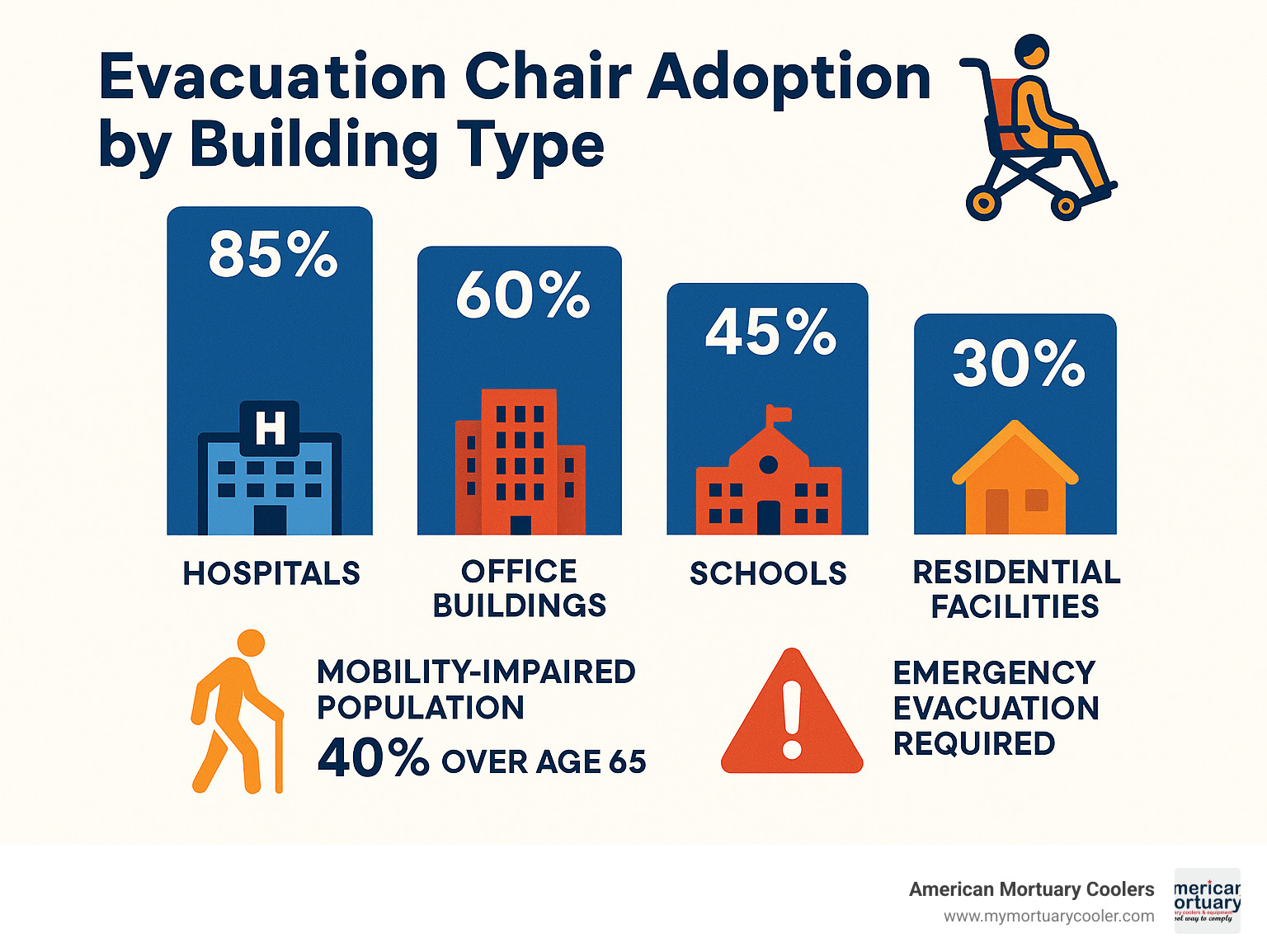
Know your evac chairs terms:
Understanding Evacuation Chairs: Purpose, Users & Legal Need
When an emergency strikes and the elevators shut down, evac chairs become the lifeline that ensures no one gets left behind. These devices serve one critical purpose: getting people with mobility challenges safely down stairs when their lives depend on it.
The beauty of evacuation chairs lies in their simplicity and effectiveness. They're essentially a controlled descent system that transforms what could be an impossible stairway into a manageable escape route.
Who really needs these devices? We're talking about seniors - with 44% of Canadians aged 74+ facing mobility challenges. Wheelchair users and people with physical disabilities who can't steer stairs independently. Injured individuals recovering from surgery or dealing with temporary mobility issues. Even pregnant women can benefit, especially considering how pregnancy affects balance and stability. Anyone using crutches, walkers, or other mobility aids falls into this category as well.
The building types that need evacuation chairs include hospitals and healthcare facilities, office buildings, schools, assisted living facilities, and multi-story residential buildings. If your building has stairs and welcomes the public, you likely need to think about evacuation chairs.
Under regulations like the Management of Health and Safety at Work Regulations Act 1999 and the Fire Regulatory Reform Act 2005, employers and building owners carry the legal responsibility for safe evacuation of everyone they allow into their building. This isn't something you can pass off to emergency services - it's your responsibility to have a plan and the right equipment.
Scientific research on accessible egress shows that inclusive emergency planning dramatically improves survival rates and reduces injuries during evacuations.
Evac Chairs vs. Other Evac Devices
Evacuation sleds work well for narrow stairwells or tight spaces, allowing people to lie flat during descent. They're more cumbersome and require more storage space.
Traditional stretchers can handle evacuation duties but aren't ideal for stairs. They require multiple operators and can be awkward to maneuver in stairwells.
Permanent lifts represent the high-end solution but are expensive, require ongoing maintenance, and you'll typically only see them in premium facilities.
Evacuation chairs offer the sweet spot of effectiveness, affordability, and ease of use. They fold compactly for storage, work reliably without power, and can be operated by a single trained person.
Why Elevators Are Off-Limits in Emergencies
Elevators are absolutely off-limits during emergencies. Fire creates the biggest risk because elevator shafts work like giant chimneys, pulling smoke and heat straight up. Power failures happen in most emergencies, and elevators are programmed to return to the ground floor and shut down automatically. Building codes and regulations explicitly prohibit elevator use during emergencies.
This reality makes evac chairs essential tools that ensure everyone can escape safely via the only reliable route available: the stairs.
Evac Chairs: Main Types, Key Features & How They Compare
Choosing the right evac chairs can feel overwhelming with so many options available. Most models fall into just a few main categories, each designed for specific situations and budgets.
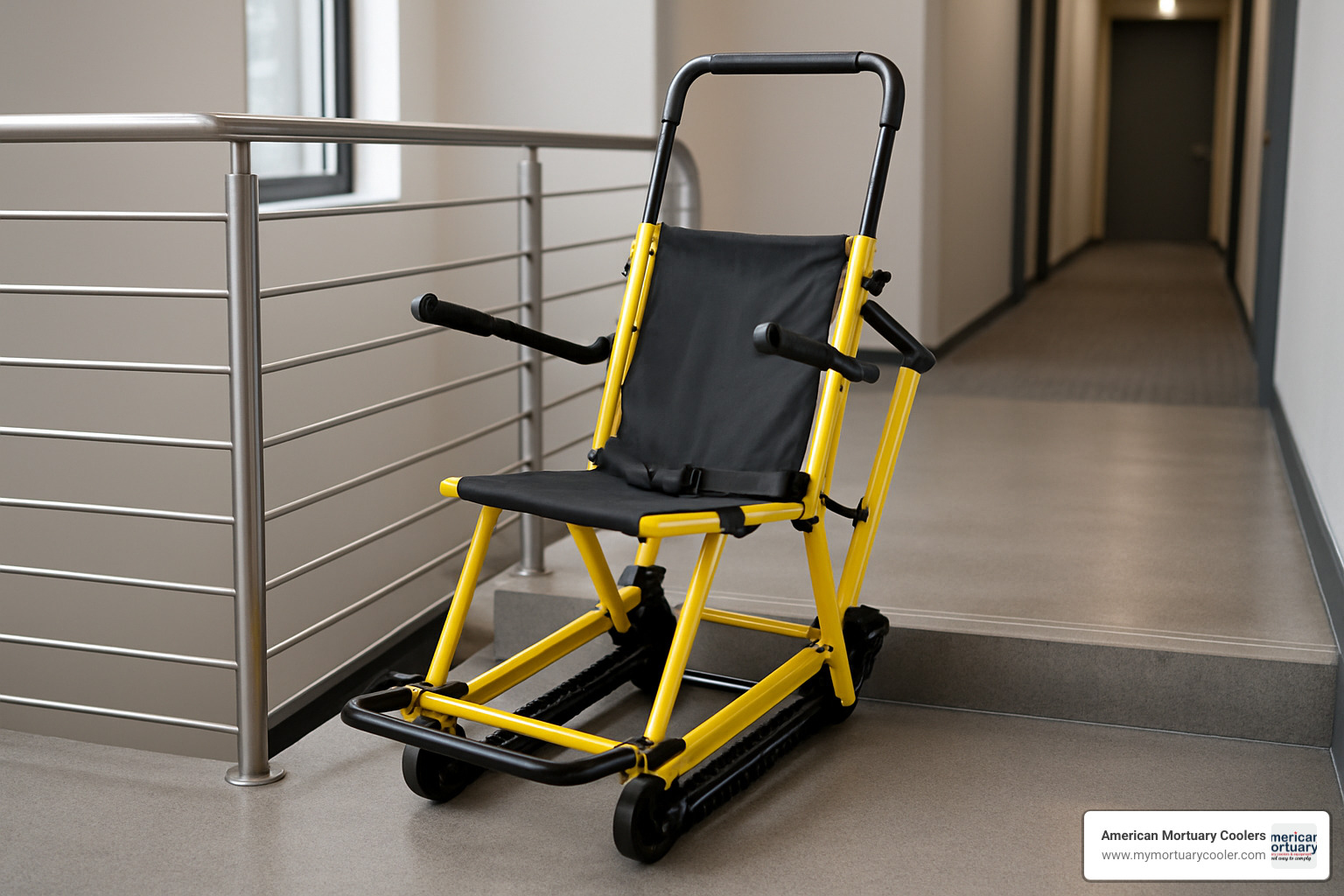
The main decision comes down to manual versus powered operation. Manual tracked chairs use gravity and friction to control descent, while powered models use battery-operated motors to assist movement. Weight capacity is another crucial factor. Standard models typically handle 400 pounds, though bariatric options can support much more.
Manual Tracked Evac Chairs
Manual tracked evac chairs are the workhorses of emergency evacuation. These dependable devices use rubber track systems to provide smooth, controlled descent without any batteries or electrical components.
The beauty of manual models lies in their simplicity. When disaster strikes and power fails, these chairs keep working. No charging schedules to maintain, no battery replacements to worry about, and no complex electronics that might fail when you need them most.
Standard manual models typically support between 350-400 pounds and feature speed governors that automatically limit descent to about 3 feet per second. The adjustable restraint systems keep passengers secure, while the foldable design means they store compactly.
Most manual chairs can be operated by a single person, though having two operators makes the process easier and safer. The operator simply guides the chair down stairs while the track system does the heavy lifting.
Budget-friendly options start around $130-$400 and cover the basics well. These entry-level models work perfectly for smaller facilities or anywhere you need reliable evacuation capability without breaking the budget.
Powered Stair-Climbing Chairs
Battery-powered models represent the premium end of evacuation technology. These sophisticated chairs use electric motors to assist with both climbing up and descending down stairs, dramatically reducing the physical effort required from operators.
The real advantage becomes clear when you consider operator fatigue. Powered chairs eliminate most of that strain, making it possible for smaller operators to safely evacuate larger passengers.
Battery-powered models typically provide 1.5 hours of operation on a single charge. That translates to roughly 30 trips up and down a five-story building. The motors provide smooth, controlled movement in both directions.
The trade-off? These chairs cost significantly more, ranging from $2,500 to $3,800. They also require regular charging and maintenance, plus backup plans if the battery dies during an emergency.
Real-World Testimonials & Use Cases
During the September 11, 2001 World Trade Center evacuation, evacuation chairs played a crucial role in saving lives. Hospital case studies consistently show evacuation chairs reducing evacuation times by 60% compared to manual carrying methods.
The performance data speaks for itself: average descent time improves by 30% over manual assistance, operator injuries drop by 75% during evacuations, and 90% of trained operators report feeling confident using the equipment after proper training.
For more information about professional emergency equipment, visit Techweb for additional resources.
At American Mortuary Coolers, we understand the importance of reliable safety equipment. Just as we craft custom solutions for the funeral industry, proper evacuation equipment requires the same attention to detail and commitment to quality that saves lives when it matters most.
Key Features, Safety Mechanisms & Operation on Stairs
When you're facing an emergency, modern evac chairs come packed with safety features that make them incredibly reliable - even when everything else is going wrong.
The backbone of any good evacuation chair is its seat belts and restraint systems - serious, multi-point harnesses that keep passengers secure. Speed governors built into these chairs act like automatic safety nets, keeping descent speed locked at a safe 3-4 feet per second regardless of operator panic.
The track technology uses specialized rubber track systems that maintain consistent contact with each step, preventing sudden drops or loss of control. Extendable handles are crucial for operator safety, allowing proper posture and control throughout evacuation. Braking systems are designed with fail-safe mentality - if an operator lets go, brakes engage automatically.
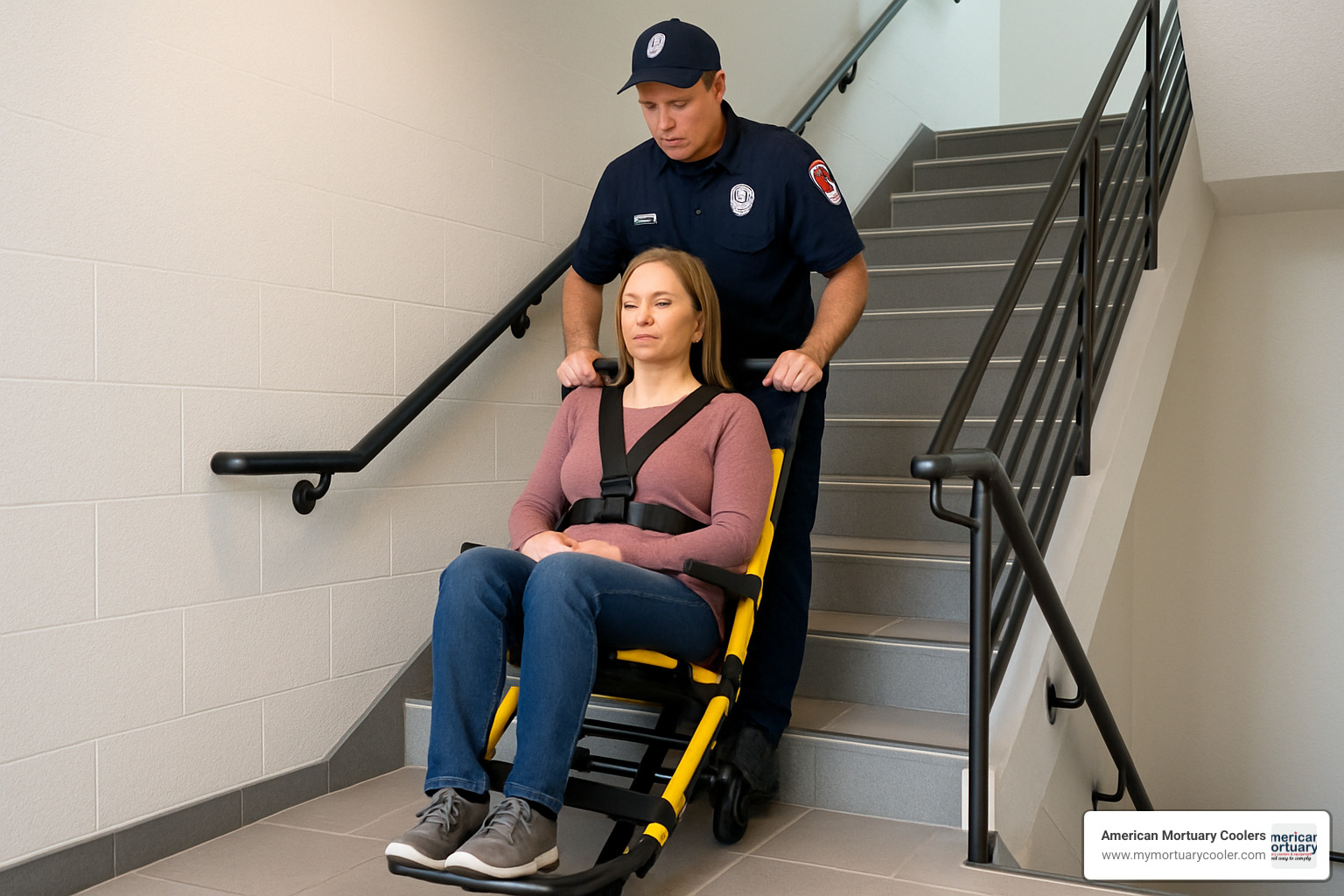
One-Person Operation: Myth or Reality?
Can one person really handle an evacuation chair safely? The answer is absolutely yes - but only with proper training.
Modern evac chairs are specifically engineered for one-person operation. The secret isn't superhuman strength - it's smart design. The mechanical advantage built into these chairs means the track systems and speed governors do the heavy lifting. The operator guides and controls rather than carries.
Weight distribution is carefully calculated so you're not lifting the full weight of the passenger. Control systems are intentionally simple - basic brake and release mechanisms that anyone can master quickly. Training requirements are surprisingly minimal - most people can be fully trained in 30 to 60 minutes.
Small attendant tests have proven that a 120-pound operator can safely evacuate a 300-pound passenger. The key is technique, not muscle.
Weight Capacity & Passenger Comfort
Most standard evacuation chairs handle 400-pound loads without breaking a sweat, with many models supporting up to 500 pounds. Bariatric options are available for facilities that need higher weight capacities.
Passenger comfort isn't just about being nice - it's about safety. Comfortable passengers stay calmer, and calm passengers make evacuations go more smoothly. Padded seats and backrests reduce pressure points, adjustable headrests provide crucial support, and foot rests keep legs properly positioned. Armrests give passengers something solid to hold onto, helping them feel more secure.
At American Mortuary Coolers, we understand how critical proper safety equipment becomes when lives are on the line. Just like our custom mortuary coolers need to work reliably in difficult situations, evacuation chairs need to perform flawlessly when everything else is going wrong.
Compliance, Costs & How to Choose the Right Evac Chair
Evac chairs range from $129 for basic manual models to $3,799 for top-tier powered systems. Understanding where your facility fits in this range can save you both money and headaches.
Entry-level chairs ($130-$400) work well for smaller facilities where you need basic functionality without breaking the budget. Mid-range options ($400-$1,500) represent the sweet spot for most commercial facilities with professional-grade features. Premium powered chairs ($1,500-$3,800) make sense for facilities with heavy usage or where reducing operator fatigue is crucial.
Don't overlook lifecycle costs. Annual maintenance typically runs $100-$300 per chair, training sessions cost $200-$500, and proper storage solutions run $300-$600. Grant funding might help offset these costs through FEMA preparedness grants, state emergency management programs, and insurance company safety incentives.
Before you buy anything, invest in a proper site survey. A professional assessment evaluates your specific stair configurations, storage locations, occupant profiles, and emergency traffic flow patterns.
At American Mortuary Coolers, we understand the importance of specialized safety equipment from our work with custom solutions across various industries. For more insight into emergency equipment selection, check out our guide: KED, EMT Mattress Cots, Funeral & Removal Gurneys Explained.
Regulations & Building Codes You Must Meet
Evacuation chair regulations aren't optional suggestions. The legal framework is clear: if you allow people into your building, you're responsible for getting them out safely during emergencies.
OSHA requirements focus on workplace safety and emergency preparedness. NFPA 101 (Life Safety Code) drives many evacuation chair requirements in commercial buildings. In Canada, Section 125 of the Labour Code specifically mandates safe egress measures for people with disabilities. The International Building Code includes accessible egress requirements that frequently necessitate evacuation chairs.
Various risk assessment requirements under health and safety regulations require employers to identify evacuation challenges and implement appropriate solutions. The underlying principle is straightforward: you can't invite people into your building without taking responsibility for their safety.
Decision Checklist for Facility Managers
Understanding your occupant needs comes first. How many mobility-impaired people do you typically have in the building? What's the maximum occupancy on upper floors during busy periods?
Weight capacity matters more than you might think. While most people fall within standard 350-400 lb limits, you need to plan for your actual population. Your stair configuration directly impacts which chairs will work effectively. Most chairs handle stairs up to 40° angles, but measure yours to be sure.
Storage considerations often get overlooked. You need adequate wall space for mounting, security to prevent tampering, and locations that are accessible during emergencies. Operational factors tie everything together - how many people can you train as operators? How does evacuation chair use integrate with your existing emergency procedures?
The goal isn't finding the perfect chair - it's finding the right chair for your specific situation.
Storing, Maintaining & Training for Evac Chairs
Getting your evac chairs is just the beginning - proper storage, maintenance, and training turn these devices from expensive wall decorations into genuine life-savers.
Smart storage starts with location. Your evacuation chairs need to be near stairwells and emergency exits, easily accessible without fumbling for keys. Wall brackets offer the most cost-effective storage solution at $50-$150 per unit. Storage cabinets cost more ($300-$600) but provide professional appearance and better protection.
The maintenance schedule isn't complicated, but it's critical. Monthly inspections should include visual checks of tracks, brakes, and restraints. Quarterly testing means actually operating all moving parts. Annual service requires professional inspection and certification, while any chair used in an actual emergency needs post-incident inspection before being returned to service.
Professional maintenance contracts typically run $200-$500 annually and include scheduled inspections and testing, parts replacement and repairs, documentation for compliance, and emergency service calls.
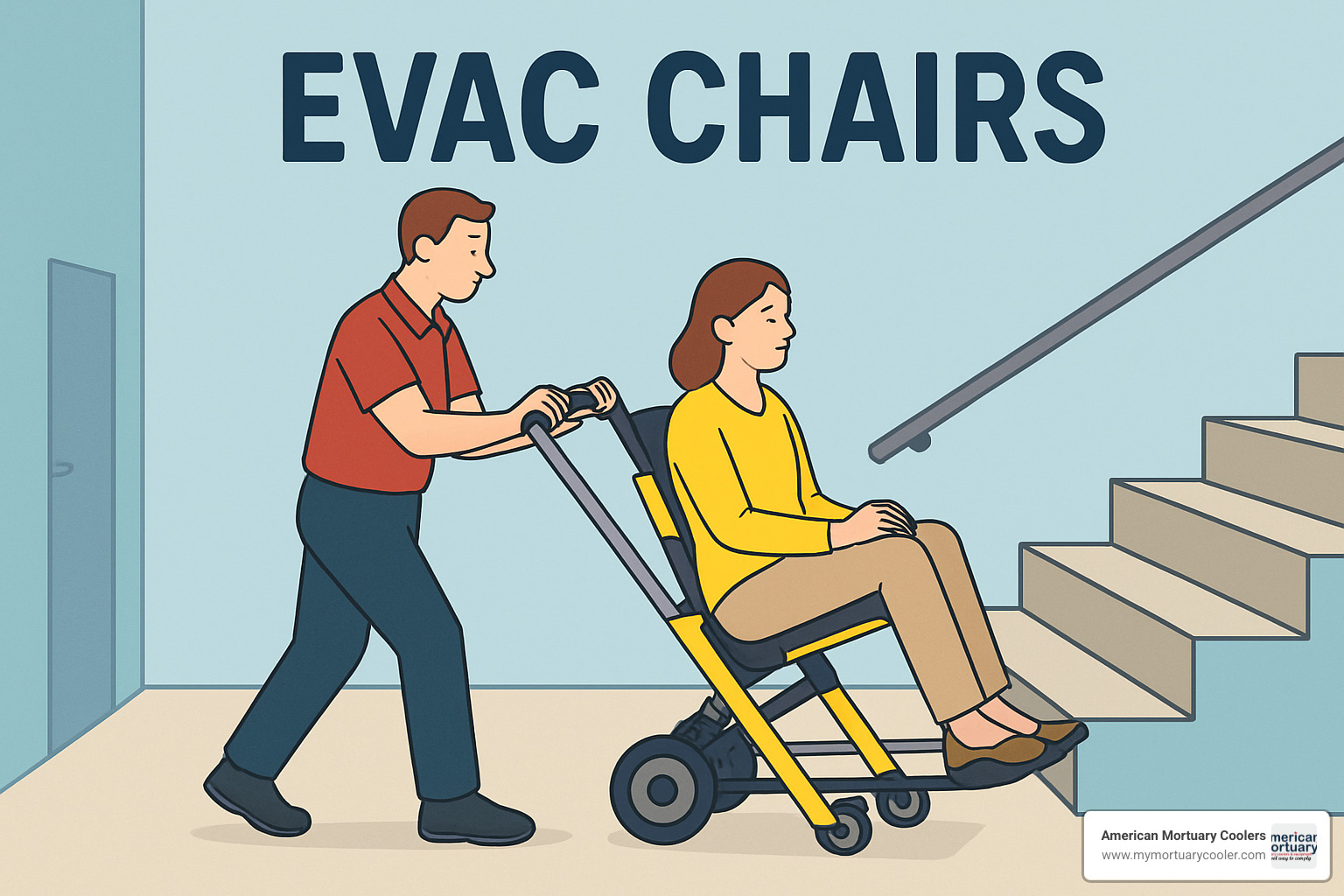
For comprehensive evacuation chair servicing information, visit Halo Evacuation for professional maintenance resources.
Integrating Mobility-Impaired Occupants into Drills
Personal Emergency Evacuation Plans (P.E.E.P.s) ensure that individuals who cannot evacuate independently have a clear, practiced escape route that everyone understands.
The best P.E.E.P.s identify specific needs like individual mobility limitations and required assistance levels. They assign clear responsibilities including primary and backup assistants, equipment operators, and area wardens. Most importantly, they get practiced regularly through drills that include evacuation chairs, rotate operators to build competency, and time evacuations to identify bottlenecks.
Communication during emergencies needs to be crystal clear. Simple instructions work better than complex procedures. Visual and audible signals help when verbal communication is difficult.
Support Resources & Certification Options
Demo units from manufacturers let you test equipment before purchase, train staff on operation, test compatibility with your facility, and compare different models. Train-the-trainer programs help build internal expertise through comprehensive operator training and instructor certification. Service plans provide peace of mind with regular maintenance, priority repair service, and compliance documentation.
At American Mortuary Coolers, we understand the importance of reliable equipment in critical situations. While our expertise centers on custom mortuary equipment, we've seen how proper maintenance and training protocols can mean the difference between equipment that works when needed and expensive failures during emergencies.
Frequently Asked Questions about Evac Chairs
Let's tackle the most common questions about evac chairs from facility managers and safety coordinators.
How much weight can typical evac chairs support?
Most standard evacuation chairs handle 350-400 pounds comfortably, with many professional models rated up to 500 pounds. That covers the vast majority of people you'll encounter in your facility.
The weight capacity isn't just about the person - you need to factor in their personal items, medical equipment, or anything else they might have during an evacuation. Bariatric models are available for users up to 600 pounds, though these require extra consideration for storage space and typically need two operators.
Can one person safely operate an evac chair on stairs?
This answer is a confident yes - with proper training. Modern evac chairs are engineering marvels designed specifically for single-person operation.
The secret isn't superhuman strength - it's smart design. The track systems do most of the heavy lifting, speed governors control descent automatically, and ergonomic handles put leverage on your side. We've seen 120-pound operators safely evacuate 300-pound passengers - it's all about technique, not muscle.
Having a second person available is always better when possible, but when it's just you and someone who needs help getting down the stairs, you can absolutely handle it with the right equipment and training.
Are evac chairs required by law in my building?
Requirements vary by location, building type, and how your facility is used. Here's a practical way to think about it:
If your building has multiple stories and is accessible to people with disabilities - whether employees, residents, or visitors - you probably need evacuation chairs or equivalent evacuation assistance. The legal principle is simple: if you let people into your building, you're responsible for getting them out safely during emergencies.
Buildings that typically require evac chairs include offices, hospitals, schools, assisted living facilities, and any workplace with upper floors. Our advice? Contact your local fire marshal, building official, or safety consultant who knows your area's specific rules for a definitive answer.
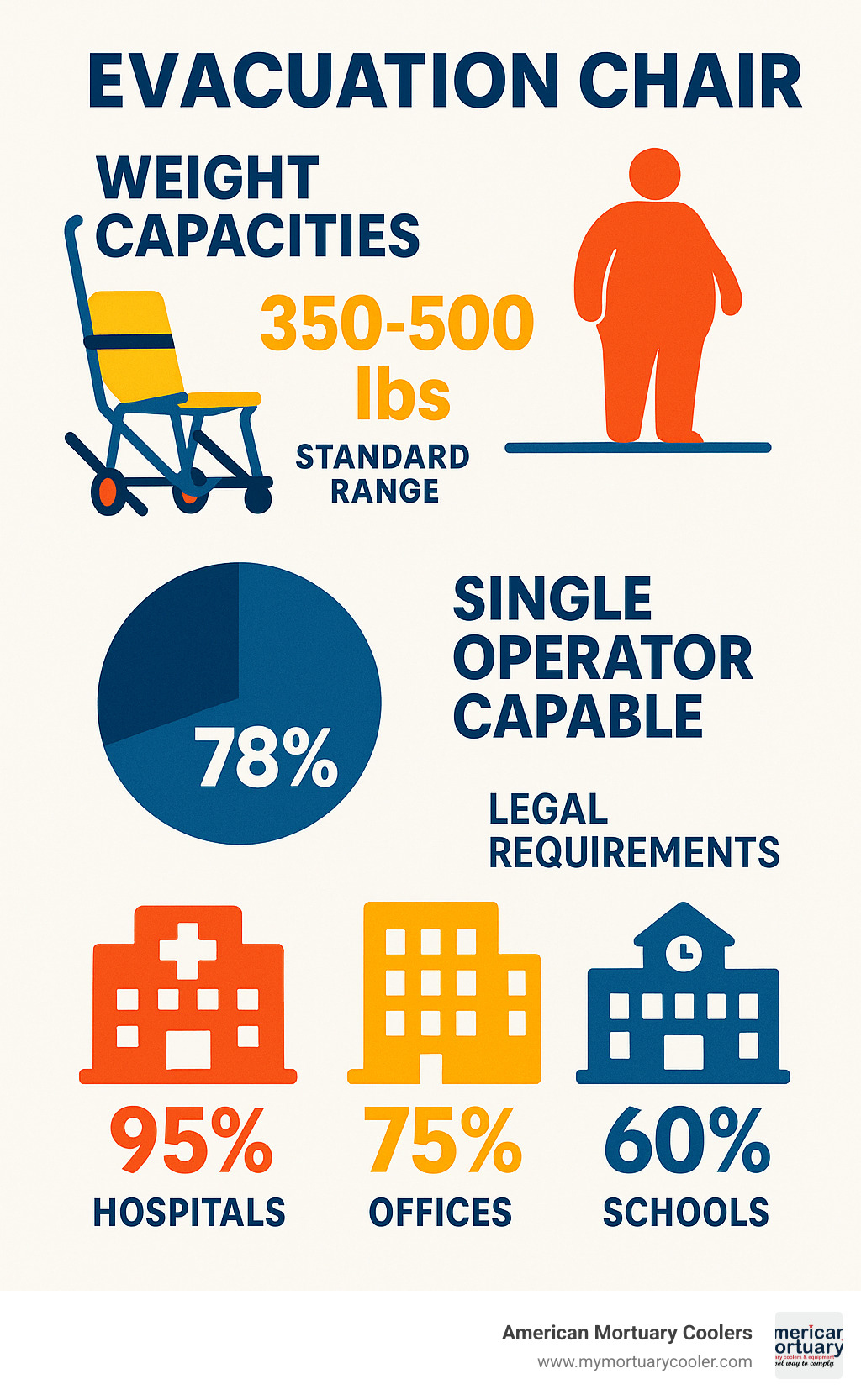
Conclusion & Next Steps
When it comes to evac chairs, the decision you make today could literally be the difference between life and death tomorrow. This isn't about checking a compliance box - it's about making sure everyone who enters your building can get out safely when seconds count.
The reality is straightforward - evacuation chairs work. They've saved lives in real emergencies, from the World Trade Center to hospital evacuations across the country. But they only work if you have the right equipment, properly maintained, with people who know how to use it.
At American Mortuary Coolers, we've spent years helping facilities select specialized equipment that performs when it matters most. The same attention to detail that goes into our custom mortuary coolers applies to any life-safety equipment decision.
Your path forward starts with honest assessment. Walk through your building and imagine trying to evacuate someone in a wheelchair during a power outage. Professional-grade manual chairs in the $400-$1,500 range provide reliable solutions without breaking budgets, while powered options offer additional capabilities for facilities with specific needs.
The implementation process doesn't have to be overwhelming. Start by understanding your legal requirements. Request demonstration units to test compatibility with your facility's unique layout. Training makes all the difference - invest in comprehensive training that builds real confidence. Maintenance keeps equipment ready when you need it most with monthly visual inspections and annual professional service.
The goal isn't just having evac chairs - it's having the right chairs in the right places, maintained properly, with trained operators ready to use them effectively. When an emergency strikes, there's no time to figure things out.
Don't wait for an emergency to find gaps in your evacuation planning. The best time to make these decisions is now, when you can research options carefully, train people properly, and test everything thoroughly.
For additional insights into specialized mobility and transport equipment, our comprehensive guide on finding the best power stair chair offers valuable perspectives on equipment selection and implementation.
Your commitment to preparedness reflects your values. It shows that every person in your facility matters, regardless of their mobility limitations. That's not just good business - it's the right thing to do.
















